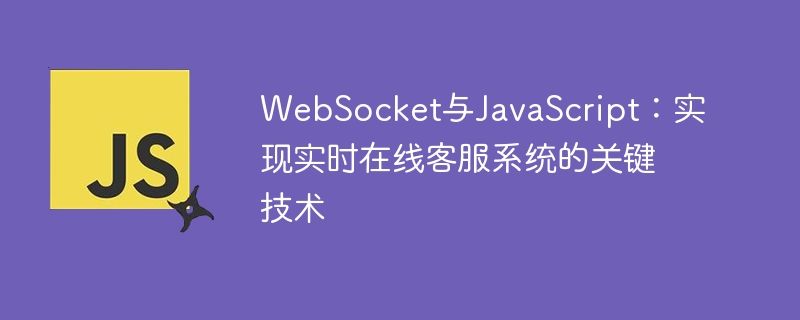Home >Web Front-end >JS Tutorial >WebSocket and JavaScript: key technologies for realizing real-time online customer service system
WebSocket and JavaScript: key technologies for realizing real-time online customer service system
- WBOYWBOYWBOYWBOYWBOYWBOYWBOYWBOYWBOYWBOYWBOYWBOYWBOriginal
- 2023-12-17 22:49:111070browse

With the development of the Internet era, more and more companies have begun to shift their customer service needs to online platforms. Providing timely and efficient services to consumers has become one of the key factors for corporate competition. As a new customer service method, real-time online customer service system can often better meet this demand.
However, implementing a real-time online customer service system is not an easy task. In the technical architecture of the system, the application of WebSocket and JavaScript is particularly critical. Therefore, this article will introduce how WebSocket and JavaScript are the key technologies to implement a real-time online customer service system, and demonstrate it with specific code examples.
What is WebSocket?
WebSocket is a full-duplex communication protocol based on the TCP protocol. Compared with the traditional HTTP protocol, WebSocket can implement long connections, thus overcoming the limitations of HTTP short connections. In addition, WebSocket also has the advantages of high efficiency, low latency, and security. Therefore, WebSocket technology has been widely used in real-time online customer service systems.
Application of WebSocket and JavaScript
JavaScript is a scripting language widely used in front-end development. In real-time online customer service systems, the combined application of WebSocket and JavaScript is very important. The WebSocket client written through JavaScript code can directly communicate with the server to achieve real-time online customer service functions. Moreover, JavaScript can also facilitate page interaction and provide users with a better customer experience.
In practical applications, the application of WebSocket and JavaScript can be divided into two parts: the client and the server. The client is mainly responsible for communicating with the server, receiving and sending messages and other operations; the server is responsible for receiving requests sent by the client, processing the requests and replying to the information. Only the cooperation between the client and the server can realize the operation of the entire real-time online customer service system.
Next, we will introduce the code example to implement a basic real-time online customer service system.
Implementing a real-time online customer service system
In this example, we use Node.js as the development environment and the WebSocket library for interaction between the client and the server. The server-side code mainly includes functions such as WebSocket creation and message sending. The specific code is as follows:
// 引入WebSocket库
const WebSocket = require('ws');
// 创建WebSocket服务器
const wss = new WebSocket.Server({ port: 8080 });
// 监听WebSocket连接
wss.on('connection', function connection(ws) {
console.log('客户端已连接');
// 接收客户端消息
ws.on('message', function incoming(message) {
console.log('收到客户端消息: %s', message);
// 将消息发送给客户端
ws.send('服务端已收到消息: ' + message);
});
// 断开连接
ws.on('close', function close() {
console.log('客户端已断开连接');
});
});The client code mainly includes operations such as connection with the server, receiving and sending messages. The specific code is as follows:
<!DOCTYPE html>
<html>
<head>
<meta charset="utf-8">
<title>实时在线客服系统</title>
</head>
<body>
<input type="text" id="input" />
<button onclick="send()">发送</button>
<div id="messages"></div>
<script>
// 创建WebSocket连接
const socket = new WebSocket('ws://localhost:8080');
// 接收服务端消息
socket.onmessage = function(event) {
// 显示消息
const element = document.createElement('div');
element.innerHTML = event.data;
document.getElementById('messages').appendChild(element);
};
// 连接成功
socket.onopen = function(event) {
console.log('已连接到服务器');
};
// 连接关闭
socket.onclose = function(event) {
console.log('与服务器断开连接');
};
// 发送消息到服务端
function send() {
const input = document.getElementById('input');
socket.send(input.value);
input.value = '';
}
</script>
</body>
</html>The above code implements a simple real-time online customer service system. After the user enters the message on the page, click the "Send" button to send the message to the server. At the same time, the client can also receive messages from the server and display them on the page.
Through the above examples, we can see that the combined application of WebSocket and JavaScript is an important technology for realizing a real-time online customer service system. Through the application of WebSocket and JavaScript, real-time data interaction can be carried out between the client and the server, thereby achieving fast and efficient customer service.
In short, the technical application of WebSocket and JavaScript is one of the keys to realizing a real-time online customer service system. Through this technology platform, it can help companies provide better and more timely customer services.
The above is the detailed content of WebSocket and JavaScript: key technologies for realizing real-time online customer service system. For more information, please follow other related articles on the PHP Chinese website!

